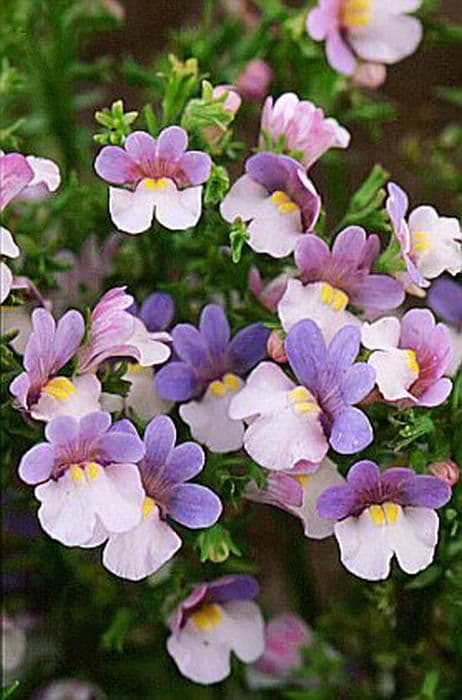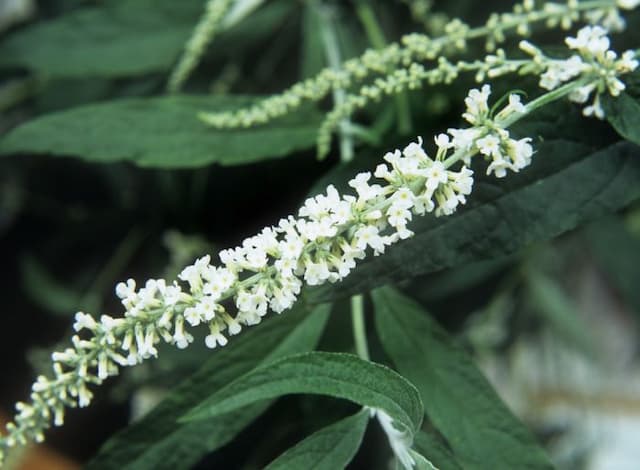Cape Jewels Nemesia strumosa

ABOUT
Nemesia strumosa, commonly known as Nemesia, is a visually striking plant known for its vibrant and colorful flowers. The appearance of this plant is characterized by a lush green foliage that serves as a backdrop to a profusion of flowers. The leaves are typically small and lance-shaped, presenting a neat and tidy appearance. The blooms of Nemesia are the most remarkable feature, with a variety of shades ranging from whites, pinks, and reds to purples and blues. The flowers are unique, with a two-lipped shape that give them a whimsical, orchid-like look. Each flower is made up of a larger, rounded lower lip and a smaller, upright upper lip. The interior of the bloom often displays delicate veining or contrasting color patterns that add to their ornate charm. These colorful flowers are grouped in clusters, creating a striking display that can add a splash of color to any garden setting. The beauty of Nemesia flowers lies in their ability to produce an abundance of blooms over a long period, often from late spring into early fall, providing a sustained visual interest. Overall, Nemesia is an attractive plant with a lush, green leafy presence and a profusion of bright, fanciful flowers that become the focal point of this delightful garden specimen.
About this plant
 Names
NamesFamily
Scrophulariaceae
Synonyms
Cape Jewels, Nemesia
Common names
Nemesia strumosa.
 Toxicity
ToxicityTo humans
Nemesia strumosa, commonly known as Nemesia, is not widely known for its toxicity to humans. There is limited information available on its potential poisonous properties, and it is not typically considered a high-risk toxic plant. However, as with many ornamentals, it is still advisable to prevent ingestion of any part of the Nemesia plant due to the potential for unknown toxins or individual allergic reactions that could occur. Ingesting plants that are not specifically intended for human consumption always carries some risk, and can potentially result in gastrointestinal discomfort or more serious symptoms in individuals who are sensitive. If accidental ingestion occurs and adverse symptoms manifest, seeking medical attention is recommended.
To pets
Nemesia strumosa, most simply referred to as Nemesia, does not have a well-documented profile of toxicity for pets such as dogs and cats. The plant is not listed among the commonly recognized poisonous plants for household pets. That being said, it is still prudent to prevent pets from ingesting any part of the Nemesia plant, because individual pets may have unique sensitivities, and not all potential toxins are well-researched or documented. If a pet ingests Nemesia, watch for signs of gastrointestinal upset or allergic reactions, which are common symptoms associated with plant ingestion by pets. Contact a veterinarian if you observe any adverse symptoms following ingestion.
 Characteristics
CharacteristicsLife cycle
Annuals
Foliage type
Deciduous
Color of leaves
Green
Flower color
Varies
Height
1 feet 12 inches [30-60 cm]
Spread
0 feet 10 inches [25 cm]
Plant type
Herb
Hardiness zones
9
Native area
South Africa
Benefits
 General Benefits
General Benefits- Colorful Display: Nemesia strumosa offers a vibrant array of colors through its flowers, enhancing the visual appeal of gardens and landscapes.
- Attracts Pollinators: The bright flowers attract bees and butterflies, which are crucial for pollination and maintaining biodiversity.
- Easy to Grow: It is known for being easy to cultivate and can thrive in a variety of climates, making it accessible for many gardeners.
- Versatility: Suitable for flower beds, borders, containers, and hanging baskets, offering flexibility in garden design.
- Long Blooming Period: Nemesia strumosa has a lengthy flowering season, providing consistent color throughout spring and summer.
- Compact Size: Its small stature makes it ideal for use in smaller gardens or as an underplanting in larger floral arrangements.
 Medical Properties
Medical PropertiesThis plant is not used for medical purposes.
 Air-purifying Qualities
Air-purifying QualitiesThis plant is not specifically known for air purifying qualities.
 Other Uses
Other Uses- As a natural pest repellent: Nemesia can be planted among vegetable gardens to repel certain pests, thanks to the fragrant scent of its flowers.
- For art and photography: The vibrant colors of Nemesia make it a great subject for botanical art and macro photography.
- In potpourris: The petals of Nemesia can be dried and used in potpourris for their color and subtle fragrance.
- As a natural dye: The colorful flowers of Nemesia may be used to create natural dyes for fabrics or crafts.
- In educational gardens: Nemesia can be used in school gardens to teach children about plant biology and the importance of pollinators.
- For companion planting: Nemesia can be grown alongside other plants to encourage healthy growth and deter harmful insects.
- In small-space gardening: Nemesia, being a compact plant, is suitable for balcony or container gardens where space is limited.
- As a living mulch: When planted densely, Nemesia can help in suppressing weeds and maintaining soil moisture.
- In celebration of seasonal festivals: Due to their bright, cheerful appearance, Nemesia flowers are used in decorations for spring and summer festivals.
- For culinary decoration: Though not commonly eaten, the flowers of Nemesia can be used as an ornamental, non-toxic garnish in culinary presentations.
Interesting Facts
 Feng Shui
Feng ShuiNemesia is not used in Feng Shui practice.
 Zodiac Sign Compitability
Zodiac Sign CompitabilityNemesia is not used in astrology practice.
 Plant Symbolism
Plant Symbolism- Success: Nemesia can symbolize success due to their vibrant and lively flowers which often signify a flourishing nature or endeavor.
- Fascination: The intricate beauty of Nemesia often relates to a fascination or intrigue, representing an individual's captivating and mesmerizing qualities.
- Friendship: With its colorful blossoms, Nemesia can symbolize friendship, offering a reflection of joy, happiness, and companionship.
- Endearment: The delicate appearance of Nemesia can be a symbol of endearment, suggesting affection and fondness in a gentle, subtle manner.
 Water
WaterCape Jewels, the common name of Nemesia strumosa, should be watered regularly to maintain moist but not waterlogged soil. During active growing seasons like spring and summer, this might equate to watering once every 2-3 days depending on climatic conditions. Each watering session should thoroughly moisten the soil to a depth of several inches. Reduce watering frequency during the fall and winter when the plant is not growing as vigorously. For outdoor garden settings, an inch of water per week, including rainfall, is generally adequate. For potted plants, use approximately 16-24 ounces per week, adjusting based on temperature and sunlight exposure.
 Light
LightCape Jewels thrive in full sun to partial shade conditions, aiming for a location where they receive at least 5-6 hours of sunlight daily. Morning light is particularly beneficial, with afternoon shade in hot climates to prevent scorching. A spot that offers bright, indirect light throughout the day is ideal, which could be near a south or west-facing window if grown indoors.
 Temperature
TemperatureCape Jewels prefer mild conditions and can thrive in an ideal temperature range between 60°F and 75°F. They can tolerate temperatures as low as 30°F but are not frost-tolerant, so they should be protected from freezes. Similarly, temperatures above 80°F can cause stress to the plant, so in particularly hot climates, some partial shade and extra water might be needed.
 Pruning
PruningCape Jewels should be pruned to encourage bushier growth and to maintain their shape. Deadheading spent flowers will also promote further blooming. The best time for a more thorough pruning is in the late winter or early spring before new growth begins. It's generally not necessary to prune more than once a year unless the plant becomes leggy during the growing season, at which point light pruning can be performed to rejuvenate the plant.
 Cleaning
CleaningAs needed
 Soil
SoilFor Cape Jewels (Nemesia strumosa), use a light, well-draining soil mix composed of peat, loam, and sand or perlite. The ideal pH for Cape Jewels should range between 5.5 and 7. A mix of two parts peat to one part loam and one part sand or perlite works well to ensure proper drainage and maintain the desired pH level.
 Repotting
RepottingCape Jewels (Nemesia strumosa) don't commonly require frequent repotting and can be repotted every 1-2 years. They should be repotted if they outgrow their current pot or if the soil is depleted and needs refreshing.
 Humidity & Misting
Humidity & MistingCape Jewels (Nemesia strumosa) prefer moderate to high humidity levels, thriving best in environments with humidity over 50%. However, they are quite adaptable and can tolerate lower humidity levels if other growing conditions are met.
 Suitable locations
Suitable locationsIndoor
Place Cape Jewels in bright, indirect light indoors.
Outdoor
Plant in partial shade and shelter from strong winds.
Hardiness zone
9-11 USDA
 Life cycle
Life cycleNemesia strumosa, commonly known as Nemesia, begins its lifecycle with seed germination, which usually occurs in spring when temperatures are mild and soil moisture is adequate. Following germination, the seedlings develop into young plants with true leaves and gradually grow to maturity, forming bushy foliage. During the flowering stage, the mature Nemesia produces a vibrant display of flowers that range from white to pink and purple, typically from late spring through summer. After pollination, which is often facilitated by insects, the flowers develop into seed capsules that eventually dry and release seeds. These seeds can fall to the ground and lie dormant through winter until conditions are favorable for the next generation to sprout. The life of the individual Nemesia plant is usually annual or biennial, often requiring replanting if gardeners wish to maintain displays year after year.
 Propogation
PropogationPropogation time
Spring-Early Summer
The most popular method of propagation for Nemesia strumosa, commonly known as Nemesia, is through seed sowing. Seeds can be started indoors about 6 to 8 weeks before the last expected frost date to get a head start on the growing season. The seeds are very fine and should be sown on the surface of a well-draining seed-starting mix, as they need light to germinate. Gently press them into the mix without covering them. It's crucial to maintain a consistent moisture level but avoid waterlogging. The ideal germination temperature is between 65 to 70 degrees Fahrenheit (approximately 18 to 21 degrees Celsius). Seedlings will typically emerge within 10 to 14 days and can be transplanted to individual pots or outdoors once the risk of frost has passed and they have developed a few true leaves.


![Butterfly bush [Florence]](/_next/image?url=https%3A%2F%2Fplants-admin.emdemapps.com%2Fimages%2Fplants%2F%2Fimages%2F604b5f52d7bb1.png&w=640&q=75)
![Butterfly bush [Marbled White]](/_next/image?url=https%3A%2F%2Fplants-admin.emdemapps.com%2Fimages%2Fplants%2F%2Fimages%2F604b63353832a.png&w=640&q=75)


![Aloha [Honey Dark Yellow]](/_next/image?url=https%3A%2F%2Fplants-admin.emdemapps.com%2Fimages%2Fplants%2F%2Fimages%2F604b53868dde8.png&w=640&q=75)
![Aloha [Raspberries and Cream]](/_next/image?url=https%3A%2F%2Fplants-admin.emdemapps.com%2Fimages%2Fplants%2F%2Fimages%2F604b57c0a7fff.png&w=640&q=75)
